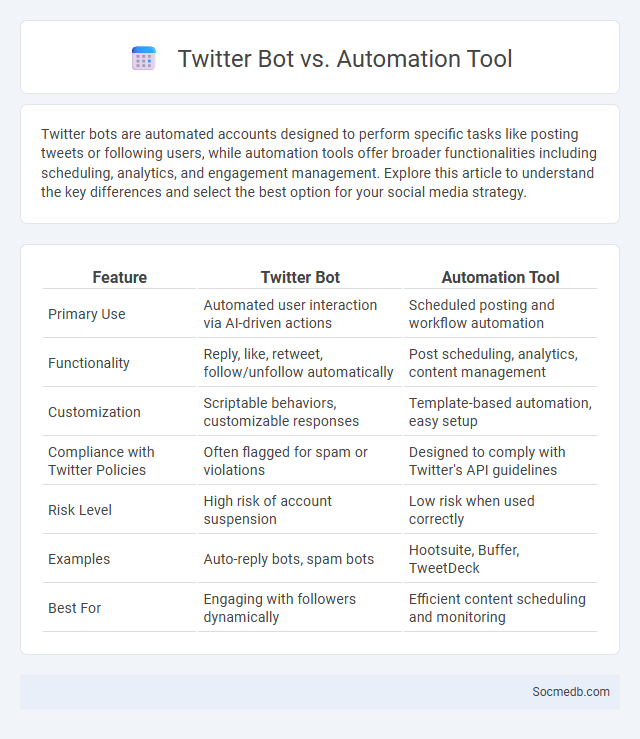
Photo illustration: Twitter Bot vs Automation Tool
Twitter bots are automated accounts designed to perform specific tasks like posting tweets or following users, while automation tools offer broader functionalities including scheduling, analytics, and engagement management. Explore this article to understand the key differences and select the best option for your social media strategy.
Table of Comparison
| Feature | Twitter Bot | Automation Tool |
|---|---|---|
| Primary Use | Automated user interaction via AI-driven actions | Scheduled posting and workflow automation |
| Functionality | Reply, like, retweet, follow/unfollow automatically | Post scheduling, analytics, content management |
| Customization | Scriptable behaviors, customizable responses | Template-based automation, easy setup |
| Compliance with Twitter Policies | Often flagged for spam or violations | Designed to comply with Twitter's API guidelines |
| Risk Level | High risk of account suspension | Low risk when used correctly |
| Examples | Auto-reply bots, spam bots | Hootsuite, Buffer, TweetDeck |
| Best For | Engaging with followers dynamically | Efficient content scheduling and monitoring |
Understanding Twitter Bots: Definition and Purpose
Twitter bots are automated accounts designed to perform specific tasks such as posting tweets, retweeting, or following users to influence discussions or amplify content. These bots serve various purposes, including marketing automation, customer service, information dissemination, and sometimes manipulating trends or spreading misinformation. Understanding the functionality and impact of Twitter bots is crucial for managing online interactions and ensuring authentic engagement on the platform.
What Are Automation Tools? Key Features and Uses
Automation tools in social media streamline content scheduling, posting, and analytics by using algorithms to manage multiple platforms efficiently. Key features include automated publishing, performance tracking, audience engagement, and campaign management, enabling businesses to save time and optimize their online presence. These tools are widely used for increasing productivity, maintaining consistent content flow, and analyzing user interaction to refine marketing strategies.
The Core Differences: Twitter Bot vs. Automation Tool
Twitter bots simulate human behavior by automatically posting tweets, retweeting, and following users based on predefined rules, often designed to amplify specific messages or trends. Automation tools provide broader functionalities, enabling scheduling, content management, and analytics across multiple social media platforms to streamline Your marketing efforts. Choosing between a Twitter bot and an automation tool depends on Your goals: bots focus on interaction mimicry within Twitter, while automation tools offer comprehensive platform management.
Types of Bots: Beyond Twitter
Social media bots extend beyond Twitter to platforms like Facebook, Instagram, and TikTok, where they automate interactions such as liking, commenting, and following. These bots include spam bots that spread unsolicited content, influence bots that amplify specific messages, and customer service bots that engage users with automated responses. Advanced bots also operate on LinkedIn and Reddit, facilitating targeted marketing campaigns and manipulating user engagement metrics.
Use Cases: When to Choose a Twitter Bot
Twitter bots are ideal for automating customer service responses, monitoring real-time trends, and managing content distribution to enhance engagement. Brands can deploy them to schedule tweets, track hashtags, and provide instant replies, ensuring timely interaction with followers. Leveraging Twitter bots helps streamline repetitive tasks, increase reach, and maintain consistent brand presence on the platform.
Use Cases: Ideal Scenarios for Automation Tools
Automation tools in social media excel in managing scheduled posts across multiple platforms, ensuring consistent brand presence and timely content delivery. These tools also enhance engagement by automatically responding to common inquiries and comments, improving customer service efficiency. Analyzing social media metrics through automation provides data-driven insights for optimizing campaigns and targeting audience segments more effectively.
Advantages and Limitations of Bots
Social media bots enhance user engagement by automating tasks such as posting content, responding to comments, and monitoring trends, enabling businesses to maintain a consistent online presence with minimal human intervention. These bots improve customer service efficiency and data gathering but often face limitations like reduced authenticity, vulnerability to spreading misinformation, and potential violations of platform policies leading to account suspensions. Effective deployment of social media bots requires balancing automation benefits with ethical considerations and platform compliance to maximize positive user experience and brand reputation.
Ethical and Compliance Considerations
Social media platforms must adhere to strict ethical guidelines and compliance standards to protect user privacy and prevent misinformation. Companies are increasingly implementing transparent data handling policies and robust content moderation practices to align with international regulations such as GDPR and COPPA. Ensuring ethical use of social media helps build trust, safeguard user rights, and mitigate legal risks.
Security Risks and Best Practices
Social media platforms pose significant security risks, including phishing attacks, account hijacking, and data breaches targeting your personal information. To safeguard your online presence, implement strong, unique passwords, enable two-factor authentication, and regularly review privacy settings on each platform. Staying vigilant against suspicious links and limiting the sharing of sensitive data helps mitigate potential threats and maintain your digital security.
How to Select the Right Solution for Your Goals
Identify your primary objectives, whether brand awareness, customer engagement, or lead generation, to tailor your social media strategy effectively. Evaluate platforms based on user demographics, content formats, and advertising capabilities to ensure alignment with your target audience. Leverage analytics tools to monitor performance and adjust your approach, maximizing ROI and achieving measurable results.
 socmedb.com
socmedb.com